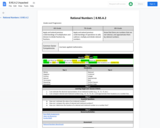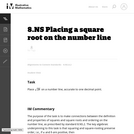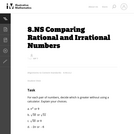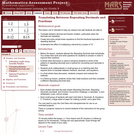
Estimate the value and compare the size of irrational numbers and approximate their locations on a number line.
- Subject:
- Mathematics
- Material Type:
- Activity/Lab
- Author:
- Liberty Public Schools
- Date Added:
- 04/13/2021

Estimate the value and compare the size of irrational numbers and approximate their locations on a number line.

This task is intended for instructional purposes so that students can become familiar and confident with using a calculator and understanding what it can and cannot do. This task gives an opportunity to work on the notion of place value (in parts (b) and (c)) and also to understand part of an argument for why the square root of two is not a rational number.

This is a task from the Illustrative Mathematics website that is one part of a complete illustration of the standard to which it is aligned. Each task has at least one solution and some commentary that addresses important asects of the task and its potential use. Here are the first few lines of the commentary for this task: Place $\sqrt{28}$ on a number line, accurate to one decimal point....

This task is intended for instructional (rather than assessment) purposes, providing an opportunity to discuss technology as it relates to irrational numbers and calculations in general. The task gives a concrete example where rounding and then multiplying does not yield the same answer as multiplying and then rounding.

This task can be used to either build or assess initial understandings related to rational approximations of irrational numbers.

Module 7 begins with work related to the Pythagorean Theorem and right triangles. Before the lessons of this module are presented to students, it is important that the lessons in Modules 2 and 3 related to the Pythagorean Theorem are taught (M2: Lessons 15 and 16, M3: Lessons 13 and 14). In Modules 2 and 3, students used the Pythagorean Theorem to determine the unknown length of a right triangle. In cases where the side length was an integer, students computed the length. When the side length was not an integer, students left the answer in the form of x2=c, where c was not a perfect square number. Those solutions are revisited and are the motivation for learning about square roots and irrational numbers in general.
Find the rest of the EngageNY Mathematics resources at https://archive.org/details/engageny-mathematics.

My goal is to merge New York State standards with Common Core Standards and Integrated Algebra Regent Standards for our 8th grade curriculum.

When students plot irrational numbers on the number line, it helps reinforce the idea that they fit into a number system that includes the more familiar integer and rational numbers.

Four full-year digital course, built from the ground up and fully-aligned to the Common Core State Standards, for 7th grade Mathematics. Created using research-based approaches to teaching and learning, the Open Access Common Core Course for Mathematics is designed with student-centered learning in mind, including activities for students to develop valuable 21st century skills and academic mindset.

(Nota: Esta es una traducción de un recurso educativo abierto creado por el Departamento de Educación del Estado de Nueva York (NYSED) como parte del proyecto "EngageNY" en 2013. Aunque el recurso real fue traducido por personas, la siguiente descripción se tradujo del inglés original usando Google Translate para ayudar a los usuarios potenciales a decidir si se adapta a sus necesidades y puede contener errores gramaticales o lingüísticos. La descripción original en inglés también se proporciona a continuación.)
El módulo 7 comienza con el trabajo relacionado con el teorema de Pitágoras y los triángulos rectos. Antes de que se presenten las lecciones de este módulo a los estudiantes, es importante que las lecciones en los módulos 2 y 3 sean relacionadas con el teorema de Pitágoras se imparten (M2: Lecciones 15 y 16, M3: Lecciones 13 y 14). En los módulos 2 y 3, los estudiantes usaron el teorema de Pitágoras para determinar la longitud desconocida de un triángulo derecho. En los casos en que la longitud lateral era un entero, los estudiantes calcularon la longitud. Cuando la longitud lateral no era un entero, los estudiantes dejaron la respuesta en forma de x2 = c, donde C no era un número cuadrado perfecto. Esas soluciones se revisan y son la motivación para aprender sobre las raíces cuadradas y los números irracionales en general.
Encuentre el resto de los recursos matemáticos de Engageny en https://archive.org/details/engageny-mathematics.
English Description:
Module 7 begins with work related to the Pythagorean Theorem and right triangles. Before the lessons of this module are presented to students, it is important that the lessons in Modules 2 and 3 related to the Pythagorean Theorem are taught (M2: Lessons 15 and 16, M3: Lessons 13 and 14). In Modules 2 and 3, students used the Pythagorean Theorem to determine the unknown length of a right triangle. In cases where the side length was an integer, students computed the length. When the side length was not an integer, students left the answer in the form of x2=c, where c was not a perfect square number. Those solutions are revisited and are the motivation for learning about square roots and irrational numbers in general.
Find the rest of the EngageNY Mathematics resources at https://archive.org/details/engageny-mathematics.
![OREGON MATH STANDARDS (2021): [8.NS]](https://img.oercommons.org/160x134/oercommons/media/courseware/lesson/image/13138_ODE_Math_Logo_2018-H_color_BvjqVNy.png)
The intent of clarifying statements is to provide additional guidance for educators to communicate the intent of the standard to support the future development of curricular resources and assessments aligned to the 2021 math standards. Clarifying statements can be in the form of succinct sentences or paragraphs that attend to one of four types of clarifications: (1) Student Experiences; (2) Examples; (3) Boundaries; and (4) Connection to Math Practices.

This lesson unit is intended to help teachers assess how well students are able to: translate between decimal and fraction notation, particularly when the decimals are repeating; create and solve simple linear equations to find the fractional equivalent of a repeating decimal; and understand the effect of multiplying a decimal by a power of 10.